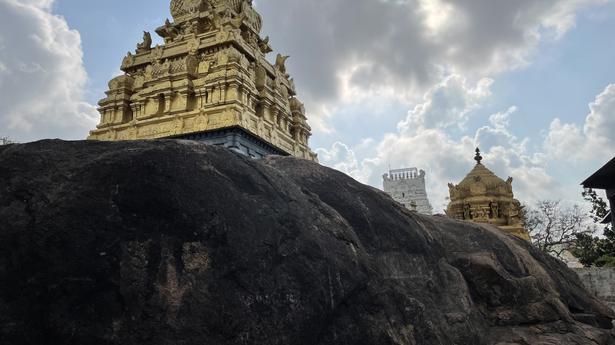
Singaperumal Koil: A temple carved out of a hillock
The Hindu
Singaperumal Koil, dating back to the Pallava period, is among the country’s well-known cave temples
Singaperumal Koil, located around 45 km from the city, has an ancient cave shrine to Narasimha. Sengundram, located five km away, is now better known for the clutch of industrial houses that have set up base there. It is difficult to conjecture that the narrow road leading from Singaperumal Koil to Sengundram connects the two places with a common name and a history that goes back to the Pallavas. Sengundram, as the name indicates, means red hill and it refers to Singaperumal Koil. Though the hillock now appears black, it seems to have once been of reddish hue. The name in Sanskrit is Patala (red) Adri (hill). In the Chola period the area was known as Sengundra Nadu, which was part of Kalattur Kottam.
The sanctum at Singaperumal Koil is built around the large carved Narasimha, attributed to the Pallavas and dating to around the eighth century. The open-mouthed idol that fills the entire space reminds of verse 23 of Andal’s Thiruppavai, where she describes the way a lion wakes up, stretches, roars, and then emerges from its cave. The deity is four-armed, wielding conch and discus, with one arm dispelling fear and the other resting on his thigh. One leg is folded while the other dangles on to the pedestal. What is unique about the idol is the presence of a third eye, on the forehead. The priest obligingly lifts the Vaishnavite mark to reveal this. Below this magnificent carving is a tiny Narasimha seated on Adi Sesha. This is the Kautuka Bera or the deity of daily worship. In addition, there is a unique standing four-armed Narasimha icon made of Panchaloha, with Adi Sesha as the canopy. This is Pradosha Narasimha, who is brought out in procession on the 13th day of the waxing phase of the moon. The regular processional icon, known as Prahlada Varada, is an icon of Vishnu flanked by consorts.
The Chola era inscription
On either side of the Narasimha sanctum are shrines to Ahobilavalli, Andal, Lakshmi Narasimha and Vishwaksena. All of these, including the Narasimha sanctum, open to a common mandapa whose pillars belong to the Chola period. Surviving inscriptions reveal that the deity here was known as Narasinga Vinnagar Deva or Azhwar. The earliest such writings here pertain to the era of Raja Raja I (r 985-1014AD) and speak of local rather than royal patronage. A unique feature in this pavilion is the motif of the Kurma Avatara of Vishnu on the ceiling — there are several tortoises and depictions of Rahu trying to swallow the sun and the moon.
It is believed that the temple fell into disuse and was covered by sand dunes after the Cholas . The shrine was resurrected by Swami Annavilappan, direct descendant of Mudaliandan Swami, nephew of Sri Ramanuja. The Mudaliandan Swami Thirumaligai, located on the main street leading to the temple, reinforces this connect.
The temple received support also from the Vijayanagar and Nayak kings. There are two carved pillars belonging to that era at the entrance to the row of shops at right angles to the temple that indicate plans to build a gopuram or a mandapam that was later abandoned. A four-pillared mandapa, with the Dasavatara carved on it, seems to be of late 18th or early 19th century origin, and is situated a little before the entrance. It also has a relief of the patron and his wife, though there is no mention of who they are. A stone deepasthamba fronts the flagstaff of the temple, indicating its Vijayanagara origins.
By the time of the East India Company and the British Raj, Singaperumal Koil seems to have received patronage from the community of Arya Vaisyas, who became prosperous as middlemen and translators. Another four-pillared mandapam, once again with the dasavatara on its pillars, stands before the Paramapada Vasal of the temple. This has the effigy of a patron and his wife prostrating and an inscription in Telugu. Another effigy of a couple records the munificence of Udayagiri Ramachandra Chettiyar and his wife. Fronting the temple proper is a sixteen-pillared mandapam of the early 20th century. The structure was built in 1916 by Nachiyar Ammal, wife of Veeraraghava Venkatachariar of an unidentifiable village in Saidapet taluk. The stone slabs on the floor were supplied by the prominent benefactors, Calavala Cunnan Chetty and his brother Ramanujam Chetty. The roofing was public funded. In more recent times, the temple has acquired a five-tiered gopuram.













